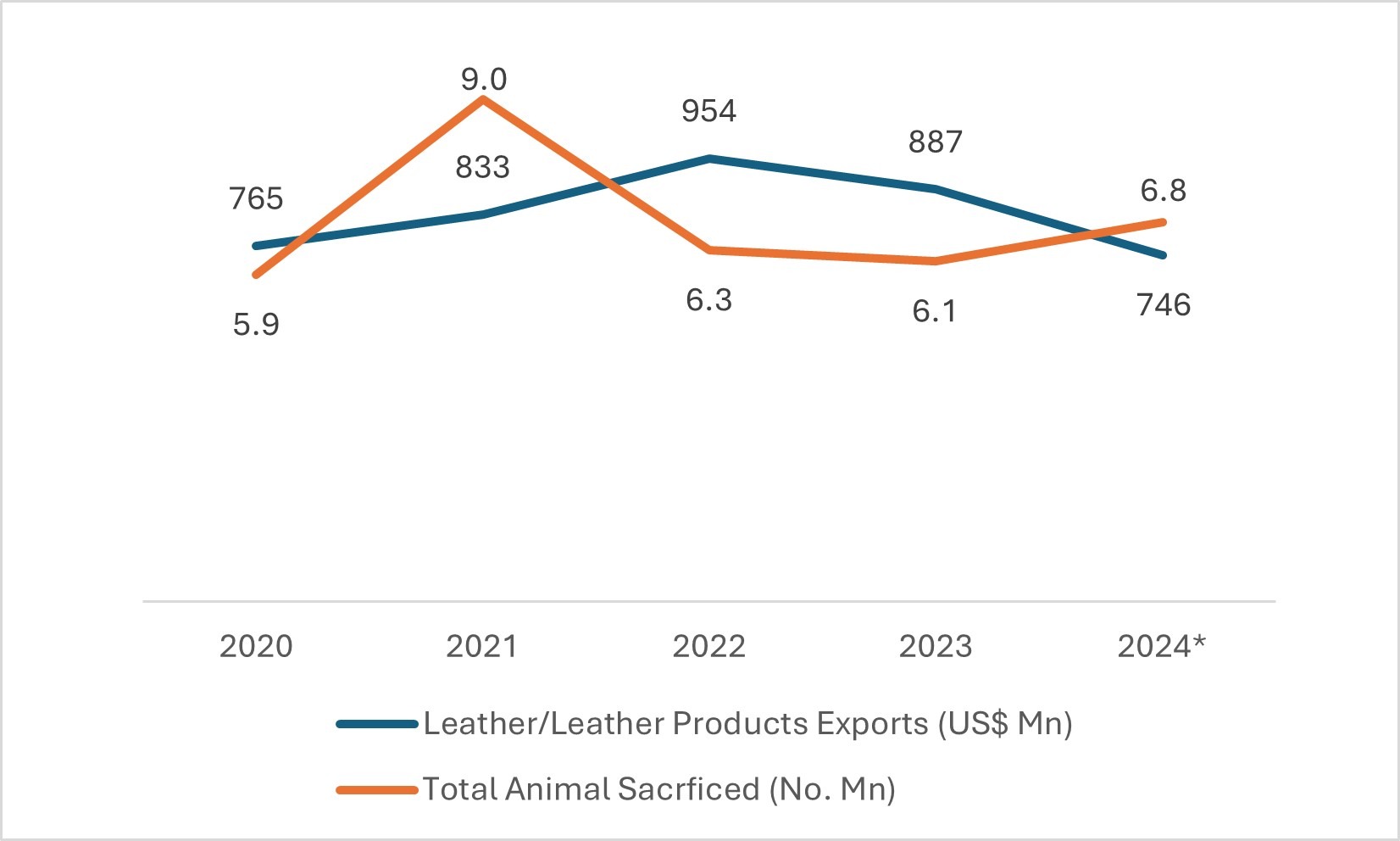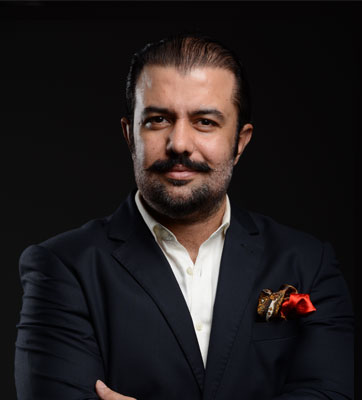Pakistan’s religious tourism, animal sacrifice and related exports collectively make up for at least $7.8 billion worth of economics, annually, where spending include estimated $3.5bn on outward religious tourism, and $3.0bn of sacrificial spend, while earnings include $427mn of meat exports, and $750-950mn of leather products exports.

We will focus on annual sacrificial spending and the associated economic value-added potential for Pakistan.
Eid ul-Adha, a major annual festival in the religion of Islam, involves the ritual sacrifice of animals that takes place globally. In 2024, over 10 million animals were sacrificed in Bangladesh alone. Globally, the number of animals sacrificed during this festival is much higher, reaching hundreds of millions, considering the large Muslim populations in countries such as India, Pakistan, Indonesia, and various Middle Eastern nations, each contributing significantly to the total number of sacrificial animals.
Pakistan ranks among the top-five nations in terms of the number of animals sacrificed during Eid ul-Adha.
In Pakistan, the practice of animal sacrifices during Eid-ul-Adha holds profound cultural and religious significance. Beyond its spiritual importance, this tradition represents a significant economic opportunity that remains largely untapped.
Consider these staggering numbers: Annually, Pakistan spends billions on outward religious tourism and animal sacrifices alone. In 2024, the country’s estimated expenditure on Hajj, Umrah and Ziyarat collectively stood at $3.5 billion (with Umrah having 57% share, and second highest globally in Hajj and Umrah visitors), while that on sacrificial animals is estimated to be PKR 700 billion ($2.5 billion), a substantial figure that underscores the economic scale of the religious tradition.
Further, if the expenses incurred on transportation of these animals, their feed and expenses on slaughtering are added, then the amount spent increases by 20% further, reaching PKR 840 billion ($3.0 billion). If we keep our focus on sacrificial animals in this piece, the economic impact animal sacrifice alone extends beyond mere spending. The leather industry, heavily reliant on animal hides, benefits immensely from this annual ritual. Eid-ul-Adha alone accounted for 37% of the total demand for hides, translating into billions of rupees in revenue for the value chain. The potential doesn’t stop there; through proper processing and value addition, the value of hides can increase exponentially, leading to a thriving export market for leather goods.
However, the current process is far from optimal. Informal slaughter practices, often conducted on streets without proper facilities (hardly any civilized country allows such a practice by the public doing it themselves on the roads and streets), lead to significant losses in both quality and economic potential. Inexperienced handling of hides further diminishes their value, affecting not only local industries but also potential exports.
Annual Animal Sacrifice – Economics & Potential
Livestock is integral to Pakistan’s rural economy, involving over 8 million families. Livestock represents 61% of the agricultural sector and 15% of GDP, growing by 3.89% in FY24 compared to 3.70% in FY23.
During Eid, Pakistani Muslims perform millions of sacrifices annually, constituting a vital economic activity. However, this sector’s productivity and economic potential remain largely untapped due to insufficient policy focus.
The number of sacrifices runs in millions, as per data gathered from All Pakistan Leather Garments and Pakistan Tanners Association. Here is the trend of animal sacrifices that take place in Pakistan every Eid-ul-Adha, in the last five years:
| Year | Total Animals Sacrificed (est.) | Change YoY | Total Value (PKR Bn) incl. expenses (est.) | Change YoY | Total Value (US$ Bn) (est.) | Cost Per Animal incl. expenses (est.) (PKR) |
| 2024 | 6,800,000 | 11% | 840 | 32% | 3.02 | 123,529 |
| 2023 | 6,100,000 | -3% | 637 | 41% | 2.28 | 104,459 |
| 2022 | 6,300,000 | -30% | 451 | -6% | 2.16 | 71,619 |
| 2021 | 9,000,000 | 54% | 480 | 64% | 3.00 | 53,333 |
| 2020 | 5,860,000 | -28% | 293 | -22% | 1.80 | 50,068 |
Source: Pakistan Tanners Association, Pakistan Leather Garments Manufacturers & Exporters Association, Media Reports, PBS ABC Research estimates
Goats make up for 45-50% of the total followed by cows making up about 40-45% of total animal sacrifices, and the rest by buffaloes and camels. This totals more than three quarters to a trillion rupees in a pure cash economy, which also needs to be contained into the formal economy – some online buying did take place in year 2020 because of Covid-19 restrictions. Besides PKR 840 billion sacrificial value exchange in 2024, skin hides (raw material to industries) are also worth billions. As per the industry, Eid-ul-Adha makes up 37% of total hides demand for the industry.
The data suggests that as raw material, the cows’ hide is estimated to be worth PKR 6.3 billion this year, while goats’ hide is worth PKR 2.1 billion (total PKR 8.4 billion). After first cleaning and undergoing chemical process, these hides’ value is estimated to be worth PKR 25 billion (over 3x its original value due to value added).
And then, further value additions take the worth to over PKR 51 billion (over 6x its raw value). Then the leather products (shoes, jackets, handbags and so on) amongst others, may take it to hundreds of billions, which mostly fetch high-value exports.
So, in total, in 2024, a PKR 840 billion worth of sacrificial exchange activity followed by at least PKR 100 billion worth of value-added products, should collectively create PKR 940 billion ($3.4 billion) worth of economic value in a matter of a few months only. Of this, leather products’ exports alone fetch around $200-250 million out of total leather products’ exports of $750-950 million annually (as per the recent years’ trade data).
In an informal sacrifice process (public doing it openly on streets/roads, or at homes, for the most part), a significant loss is incurred during the initial sacrificial and skin peel process as inexperienced butchers and amateurs, with the absence of formal slaughterhouses result in the quality of the hides being compromised, and loss of this precious raw material for the industry.
As per the tanners’ industry, the wastage of hides reached 40% (from the point of sacrifice to what reaches the industry, eventually), primarily due to the hot weather and the reasons mentioned above. As a result, the industry’s reliance on hides from sacrificial activity has now reduced to 20%, from over 35% in recent years.

Source: Pakistan Tanner’s Association, PBS
*11-month period ending May 2024
The trend in animal sacrifices during Eid ul-Adha continues to rise positively in Pakistan over the years. However, leather and leather-related exports are witnessing a decline.
In 2021, the total number of animal sacrifices during Eid ul-Adha saw a significant growth of 54% YoY. However, despite the increase, the leather export industry only exhibited a modest growth of 15% in the following year, the disparity highlighting the missed potential within the industry to efficiently convert the abundant hides into valuable leather products.
Pakistan, despite being among the top five nations in terms of the number of animals sacrificed during Eid ul-Adha, lags behind Bangladesh and Turkey in terms of total export value of leather and leather goods.
Leather exports US$ Mn FY2023, Source: Media Reports
In FY23, Bangladesh’s export of leather and leather products reached $1.1 billion, solidifying its position as a major global exporter. The Bangladeshi government aims to transform the sector into a $10 billion industry and is taking significant steps to boost production and export. Despite the ongoing global economic crisis, Bangladesh’s leather sector achieved an impressive YoY growth of 17.56% in FY23, reflecting the country’s resilience and strategic efforts to expand its leather industry.
Meanwhile, in Turkey, families are facing financial struggles to perform the traditional Eid ul-Adha animal sacrifices due to high inflation. The price of cattle increased by nearly 300% YoY in FY23, making it challenging for local farmers to sell and for citizens to buy animals at affordable prices. Despite the decline in cattle sales for sacrificial purposes, Turkey’s total leather exports in 2023 stood at $1.8 billion, suggesting that while domestic sacrifices may have decreased, the leather industry still found ways to maintain strong export performance.
The induction of technology and relevant skillset, if developed properly through a policy framework by the government, can turn this industry into a multi-billion-dollar exports industry from Pakistan. Therefore, the solution lies in modernization and formalization. By establishing state-of-the-art slaughterhouses and introducing advanced processing techniques, Pakistan can not only improve the quality of its hides but also ensure a cleaner, more efficient process. This transformation would not only benefit the leather industry but also create employment opportunities and attract foreign investments eager to capitalize on Pakistan’s meat and leather potential.
Moreover, embracing digital solutions for transactions can streamline the financial aspect of these transactions, reducing the reliance on cash and enhancing transparency. This shift towards formalization would not only integrate this massive economic activity into the formal economy but also ensure sustainable growth and societal benefits, including better health practices and improved meat quality.
By recognizing immense economic potential that Eid-ul-Adha yields every year, Pakistan can pave the way for a robust export industry in meat and leather products. With the right policy framework and infrastructure investments, this tradition could transform into a cornerstone of Pakistan’s economy, generating billions in exports and creating a prosperous future for its people.
A formalized approach, including modern slaughterhouses (instead of people doing themselves on streets and roads), physical and technology infrastructure with skilled labor while developing entire value-chain, promises multiple benefits:
- Availability of quality of raw material for the industry with right value and timely preservation of skins/hides
- Better and cleaner environment from public healthcare perspective
- Availability of high-quality meat for both local use as well as exports
- It will help generate skilled jobs and bring institutional investments into this area (Chinese and Arabs are eagerly looking to invest in meat industry), and
- Huge cash activity can also be captured via digital means with right mix of incentives for online payments
By developing and formalizing the relevant ecosystem thereby improving on the wastage of the important raw material with increase in volumes, the exports of leather and allied industries could easily be reached three to four times its present value i.e. $3.0-4.0 billion, from considerably below $1 billion at the moment.
By adopting a strategic policy framework and investing in infrastructure, Pakistan can transform this sector into a lucrative export market for leather, value-added products, and meat. Incentives for investors and digital payment mechanisms are crucial steps toward realizing this economic potential, positioning Pakistan’s “Meaty Economy” for significant growth.

Khurram Schehzad is an Investment Banker and Tech Entrepreneur by profession, a Development Economist by passion. Khurram has been advising Governments, Corporates, Financial Institutions, Startups and Investors on growth and transformations. His work experience spans more than 19 years across key financial disciplines, including Investment Banking, Corporate Finance, Investment Advisory & Strategy, Economic Policy & Research, and Asset & Portfolio Management.